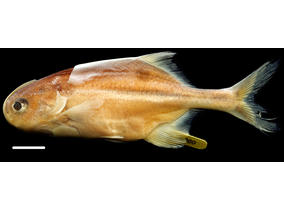Vous êtes ici
Mormyridae
Petrocephalus valentini Lavoué, Sullivan & Arnegard 2010
Nomenclature
-
Subfamily: PetrocephalinaeGenus: Petrocephalus
SUMMARY
Petrocephalus valentini is a small sized species within the genus (maximum standard length = 77.2 mm, holotype). Body ovoid, body 2.8 to 3.0 longer than high and laterally compressed. Head length between 3.4 and 3.7 times in standard length (paratype average = 3.6, holotype = 3.4). Snout short and round. Mouth small (4.7 ≤ Head length/mouth width ≤ 5.8) and sub–terminal, positioned under the anterior half of the eye. Eye large (2.9 ≤ Head length/Eye diameter ≤ 3.2). Teeth small and bicuspid, 7–12 (median = 9) in a single row in the upper jaw, 15–17 (median = 16) in the lower jaw. Dorsal and anal fins originate in the posterior half of the body (1.6 ≤ standard length /Pre–dorsal distance ≤ 1.7 and standard length / Pre–anal distance = 1.6). Pre–dorsal distance approximately equal to the pre–anal distance. Dorsal fin with 19–24 branched rays (median = 22). Anal fin with 24–26 branched rays (median = 25). Scales cover the body, except for the head. Lateral line visible and complete with 35–36 pored scales along its length. Nine to 12 scales (median = 11) between the anterior base of the anal fin and the lateral line. Caudal peduncle relatively thin (2.2 ≤ Caudal peduncle length/ Caudal peduncle depth ≤ 2.5, paratype average = 2.3, holotype = 2.3). Twelve scales around the caudal peduncle. Skin on head thick, turning opaque with formalin fixation. Knollenorgans clearly organized into two visible rosettes (the Augenrosette and the Nackenrosette). The third rosette, the Kehlrosette, is also present but this structure is not as visible as it is in other species (e.g., Petrocephalus binotatus).
Body uniformly white–silver, with two faint black patches, sometimes hardly distinguishable: (1) a dorsal mark on each side of the body, below the anterior base of the dorsal fin under the second to the sixth rays; (2) an ovoid/crescent–shaped mark centered at the base of the caudal fin (sometimes the center of this second mark is less distinguishable than two arms of the crescent, each slightly extending onto the upper and lower parts of the caudal fin). There is no melanin marking at the base of the pectoral fins. Fins translucent.




